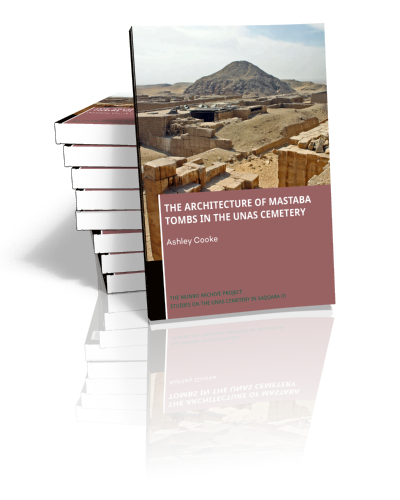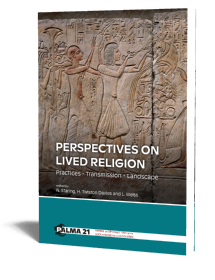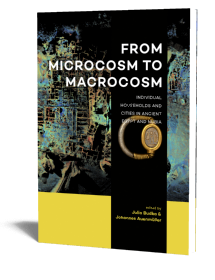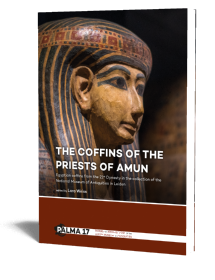The Architecture of Mastaba Tombs in the Unas Cemetery
Ashley Cooke | 2020

The Architecture of Mastaba Tombs in the Unas Cemetery
Ashley Cooke | 2020
Paperback ISBN: 9789088908941 | Hardback ISBN: 9789088908958 | Imprint: Sidestone Press | Format: 182x257mm | 194 pp. | The Munro Archive Project. Studies on the Unas Cemetery in Saqqara 01 | Language: English | 94 illus. (bw) | 36 illus. (fc) | Keywords: Egyptian archaeology; Egyptology; Saqqara; Old Kingdom; mastabas; funerary architecture; masonry; pyramids | download cover
Read online or downloaded 1726 times
-
Digital & Online access
This is a full Open Access publication, click below to buy in print, browse, or download for free.
-
Buy via Sidestone (EU & UK)
-
Buy via our Distributors (WORLD)
For non-EU or UK destinations you can buy our books via our international distributors. Although prices may vary this will ensure speedy delivery and reduction in shipping costs or import tax. But you can also order with us directly via the module above.
UK international distributor
USA international distributor
-
Bookinfo
Paperback ISBN: 9789088908941 | Hardback ISBN: 9789088908958 | Imprint: Sidestone Press | Format: 182x257mm | 194 pp. | The Munro Archive Project. Studies on the Unas Cemetery in Saqqara 01 | Language: English | 94 illus. (bw) | 36 illus. (fc) | Keywords: Egyptian archaeology; Egyptology; Saqqara; Old Kingdom; mastabas; funerary architecture; masonry; pyramids | download cover
Read online or downloaded 1726 times

We will plant a tree for each order containing a paperback or hardback book via OneTreePlanted.org.
Until comparatively recently, there has been little attempt to produce a detailed study of the architectural make-up of multi-roomed mastaba tombs and the implications of these observations for understanding the ways in which this type of tomb was really used. No thorough and comprehensive investigation has ever been dedicated to the building techniques, materials and design of mastabas or, indeed, who built them.
“The Architecture of Mastaba Tombs” considers the architectural components of tomb design that made an ideal burial and explores different aspects of the design and construction of mastabas in the late Old Kingdom (c. 2375 – 2181 BC). It focuses on a group of multi-roomed mastabas in the Unas Cemetery at Saqqara that can be characterised by their complex design and large size. This includes an appraisal of tombs within this cemetery and examines the layout and development of the cemetery from the reign of King Unas, at the end of the 5th Dynasty. Specific attention is paid to the techniques that were used to build tombs via the recording of masonry and examination of specific architectural elements within different monuments.
Features such as doorways and the security of the tomb and other aspects, for example the provision of storage space for the maintenance of the mortuary cult, are all considered. The study utilises published sources and survey work carried out by the author. Finally, this study addresses the imbalance of data collection within the recording of Old Kingdom mastabas.
*The Munro Archive Project. Studies on the Unas Cemetery in Saqqara 01* Series editors: André J. Veldmeijer & Martin Sählhof
Introduction
1. The Unas Cemetery
1.1. Introduction
1.2. Gazetteer of Tombs in the Unas Cemetery
2. Sources of Stone at Saqqara
2.1. Pyramid Cemeteries
2.2. Geology
2.2.1. Limestone Quarries in Egypt
2.2.2. Likely Sources of Limestone at Saqqara
2.3. Delivery Routes of Building Materials
2.4. Archaeological Observations Relating to Masonry Materials
2.4.1. Imitation of White Stone
2.4.2. Imitation of Stone
2.4.3. Imitation of Organic Material Using Stone
2.5. Acquisition of Stone
3. Masonry in Tombs at Saqqara
3.1. Introduction
3.2. Masonry Classification
3.2.1. Masonry by Cross-Section: Freestanding Walls within Mastabas
3.2.2. Surface Appearance
3.3. Masonry Techniques at Saqqara
4. Roofing
4.1. Introduction
4.1.1. Roofing in the Tomb of Mehu
4.1.2. Roofing in the Tomb of Seshseshet Idut
4.1.3. Roofing in the Tomb of Niankhba
4.1.4. Roofing in the Tomb of Mitri
4.1.5. Summary
5. Doorways
5.1. Introduction
5.2. Doors from Old Kingdom Tombs
5.3. Representations of Doors in the Old Kingdom
5.4. Doors within Tombs
5.5. Fastening Doors
5.6. A Survey of Doorways Within the Unas Cemetery
5.6.1. The Tomb of Kairer
5.6.2. The Tomb of Khenut
5.6.3. The Tomb of Nebet
5.6.4. The Tomb of Seshseshet Idut
5.6.5. The Tomb of Iynefert
5.6.6. The Tomb of Nebkauhor
5.6.7. The Tomb of Mehu
5.6.8. The Tomb of Ptahshepses Impy
5.7. Other Memphite Tombs
5.7.1. The Tomb of Mereruka
5.7.2. The Tomb of Kagemni
5.7.3. The Tomb of Khentika
5.7.4. The Tomb of Ankhmahor
5.7.5. The Tomb of Debehen
5.8. Doorkeepers
6. Courtyards, Columned Halls and Storerooms
6.1. Courtyards and Columned Halls
6.2. Storerooms for the Mortuary Cult
6.3. Storerooms in Pyramid Temples
6.4. Tombs with Five Storerooms
6.4.1. The Tomb of Nebet
6.4.2. The Tomb of Nebkauhor
6.4.3. The Tomb of Kagemni
6.4.4. The Tomb of Mereruka
6.4.5.The Tomb of Ptahhotep (LS31)
6.5. Tombs with Less than Five Storerooms
6.5.1. The Tomb of Khentika
6.5.2. The Tomb of Seshseshet Idut
6.5.3. The Tomb of Kairer
6.5.4. The Tomb of Akhethotep and Ptahhotep (D 64)
6.6. Storerooms Adjacent to Offering-Rooms
Synopsis
Bibliography
Dr Ashley Cooke
Ashley Cooke is Senior Curator of Antiquities at National Museums Liverpool, one of the largest Egyptology collections in the UK. Tomb architecture is one of his research interests, which also include ancient Egyptian material culture and the history of collecting. He has worked on fieldwork projects in Egypt since 1997 and has excavated at Saqqara, Tell Abqa’in, the Valley of the Kings and Zawiyet Umm el-Rackham.
Abstract:
Until comparatively recently, there has been little attempt to produce a detailed study of the architectural make-up of multi-roomed mastaba tombs and the implications of these observations for understanding the ways in which this type of tomb was really used. No thorough and comprehensive investigation has ever been dedicated to the building techniques, materials and design of mastabas or, indeed, who built them.
“The Architecture of Mastaba Tombs” considers the architectural components of tomb design that made an ideal burial and explores different aspects of the design and construction of mastabas in the late Old Kingdom (c. 2375 – 2181 BC). It focuses on a group of multi-roomed mastabas in the Unas Cemetery at Saqqara that can be characterised by their complex design and large size. This includes an appraisal of tombs within this cemetery and examines the layout and development of the cemetery from the reign of King Unas, at the end of the 5th Dynasty. Specific attention is paid to the techniques that were used to build tombs via the recording of masonry and examination of specific architectural elements within different monuments.
Features such as doorways and the security of the tomb and other aspects, for example the provision of storage space for the maintenance of the mortuary cult, are all considered. The study utilises published sources and survey work carried out by the author. Finally, this study addresses the imbalance of data collection within the recording of Old Kingdom mastabas.
*The Munro Archive Project. Studies on the Unas Cemetery in Saqqara 01* Series editors: André J. Veldmeijer & Martin Sählhof
Contents
Introduction
1. The Unas Cemetery
1.1. Introduction
1.2. Gazetteer of Tombs in the Unas Cemetery
2. Sources of Stone at Saqqara
2.1. Pyramid Cemeteries
2.2. Geology
2.2.1. Limestone Quarries in Egypt
2.2.2. Likely Sources of Limestone at Saqqara
2.3. Delivery Routes of Building Materials
2.4. Archaeological Observations Relating to Masonry Materials
2.4.1. Imitation of White Stone
2.4.2. Imitation of Stone
2.4.3. Imitation of Organic Material Using Stone
2.5. Acquisition of Stone
3. Masonry in Tombs at Saqqara
3.1. Introduction
3.2. Masonry Classification
3.2.1. Masonry by Cross-Section: Freestanding Walls within Mastabas
3.2.2. Surface Appearance
3.3. Masonry Techniques at Saqqara
4. Roofing
4.1. Introduction
4.1.1. Roofing in the Tomb of Mehu
4.1.2. Roofing in the Tomb of Seshseshet Idut
4.1.3. Roofing in the Tomb of Niankhba
4.1.4. Roofing in the Tomb of Mitri
4.1.5. Summary
5. Doorways
5.1. Introduction
5.2. Doors from Old Kingdom Tombs
5.3. Representations of Doors in the Old Kingdom
5.4. Doors within Tombs
5.5. Fastening Doors
5.6. A Survey of Doorways Within the Unas Cemetery
5.6.1. The Tomb of Kairer
5.6.2. The Tomb of Khenut
5.6.3. The Tomb of Nebet
5.6.4. The Tomb of Seshseshet Idut
5.6.5. The Tomb of Iynefert
5.6.6. The Tomb of Nebkauhor
5.6.7. The Tomb of Mehu
5.6.8. The Tomb of Ptahshepses Impy
5.7. Other Memphite Tombs
5.7.1. The Tomb of Mereruka
5.7.2. The Tomb of Kagemni
5.7.3. The Tomb of Khentika
5.7.4. The Tomb of Ankhmahor
5.7.5. The Tomb of Debehen
5.8. Doorkeepers
6. Courtyards, Columned Halls and Storerooms
6.1. Courtyards and Columned Halls
6.2. Storerooms for the Mortuary Cult
6.3. Storerooms in Pyramid Temples
6.4. Tombs with Five Storerooms
6.4.1. The Tomb of Nebet
6.4.2. The Tomb of Nebkauhor
6.4.3. The Tomb of Kagemni
6.4.4. The Tomb of Mereruka
6.4.5.The Tomb of Ptahhotep (LS31)
6.5. Tombs with Less than Five Storerooms
6.5.1. The Tomb of Khentika
6.5.2. The Tomb of Seshseshet Idut
6.5.3. The Tomb of Kairer
6.5.4. The Tomb of Akhethotep and Ptahhotep (D 64)
6.6. Storerooms Adjacent to Offering-Rooms
Synopsis
Bibliography
Dr Ashley Cooke
Ashley Cooke is Senior Curator of Antiquities at National Museums Liverpool, one of the largest Egyptology collections in the UK. Tomb architecture is one of his research interests, which also include ancient Egyptian material culture and the history of collecting. He has worked on fieldwork projects in Egypt since 1997 and has excavated at Saqqara, Tell Abqa’in, the Valley of the Kings and Zawiyet Umm el-Rackham.
-
Digital & Online access
This is a full Open Access publication, click below to buy in print, browse, or download for free.
-
Buy via Sidestone (EU & UK)
-
Buy via our Distributors (WORLD)
For non-EU or UK destinations you can buy our books via our international distributors. Although prices may vary this will ensure speedy delivery and reduction in shipping costs or import tax. But you can also order with us directly via the module above.
UK international distributor
USA international distributor
- Browse all books by subject
-
Search all books

We will plant a tree for each order containing a paperback or hardback book via OneTreePlanted.org.
You might also like:
© 2025 Sidestone Press KvK nr. 28114891 Privacy policy Sidestone Newsletter Terms and Conditions (Dutch)








